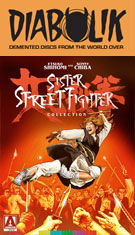



 cranking out three Street Fighter
cranking out three Street Fighter  films starring Sonny Chiba within a year, Toei was already thinking of ways to keep the franchise going with another martial arts star. The immediate answer was found in Etsuko Shihomi (dubbed "Sue Shiomi" in the U.S. in the usual New Line fashion), a teenage martial arts pro who had appeared with her friend and colleague Chiba in small roles in the first and third Street Fighter productions. For Sister Street Fighter, she took center stage as Li Koryu (or Tina in the U.S. version), who's enlisted to use her investigative and combat skills when her undercover cop brother gets abducted by drug dealers while on an assignment between Japan and Hong Kong. She ends up getting help from dojo master Hibachi (Chiba) and others as she ends up facing off against a criminal organization fronted by dummy company Central Export, run by the evil, claw-handed Kaki (Amatsu). Numerous kidnappings, double crosses, and violent deaths ensue as she closes in on her prey and tries to find out exactly what happened to her brother.
films starring Sonny Chiba within a year, Toei was already thinking of ways to keep the franchise going with another martial arts star. The immediate answer was found in Etsuko Shihomi (dubbed "Sue Shiomi" in the U.S. in the usual New Line fashion), a teenage martial arts pro who had appeared with her friend and colleague Chiba in small roles in the first and third Street Fighter productions. For Sister Street Fighter, she took center stage as Li Koryu (or Tina in the U.S. version), who's enlisted to use her investigative and combat skills when her undercover cop brother gets abducted by drug dealers while on an assignment between Japan and Hong Kong. She ends up getting help from dojo master Hibachi (Chiba) and others as she ends up facing off against a criminal organization fronted by dummy company Central Export, run by the evil, claw-handed Kaki (Amatsu). Numerous kidnappings, double crosses, and violent deaths ensue as she closes in on her prey and tries to find out exactly what happened to her brother.  Speaking of
Speaking of  which, Sister Street Fighter: Hanging by a Thread sticks to the formula as Koryu takes time out from her busy apple eating to beat up a gang of rough Korean smugglers. The man she saves, a Hong Kong cop who has one clear eye, gasps that "You have to tell Professor Emmei Oh..." before getting shot by a deadly dart. The dead man's eyeball turns out to be an implanted clue pointing her to a martial arts fortress where her high school friend, Birei, is being held. The mission ends up pitting her against more gangsters, this time nefarious diamond smugglers who use women as their mules by, uh, surgically embedding the gems into their posteriors. As usual, the bad guys are a bizarre bunch including a scalpel-wielding doctor and a few others who won't be spoiled here. Completely ridiculous with a plot that isn't too far off from a Chesty Morgan movie, this one's also lots of fun and finds everyone clearly trying to outdo the prior film on the outrageousness scale.
which, Sister Street Fighter: Hanging by a Thread sticks to the formula as Koryu takes time out from her busy apple eating to beat up a gang of rough Korean smugglers. The man she saves, a Hong Kong cop who has one clear eye, gasps that "You have to tell Professor Emmei Oh..." before getting shot by a deadly dart. The dead man's eyeball turns out to be an implanted clue pointing her to a martial arts fortress where her high school friend, Birei, is being held. The mission ends up pitting her against more gangsters, this time nefarious diamond smugglers who use women as their mules by, uh, surgically embedding the gems into their posteriors. As usual, the bad guys are a bizarre bunch including a scalpel-wielding doctor and a few others who won't be spoiled here. Completely ridiculous with a plot that isn't too far off from a Chesty Morgan movie, this one's also lots of fun and finds everyone clearly trying to outdo the prior film on the outrageousness scale.  sinister corporation. Clues point to a Yokohama nightclub, and on top of that, Sho's murder has our heroine transporting little girl
sinister corporation. Clues point to a Yokohama nightclub, and on top of that, Sho's murder has our heroine transporting little girl  Rika, whose mother is tied up in the criminal gold smuggling plot as well. Interestingly, this is probably Shihomi's best performance in the series as she's obviously grown as an actress, particularly when it comes to nonverbal expressions. Essentially this one's another collection of energetic action sequences and bizarre characters, making it a worthy send off for the film series proper.
Rika, whose mother is tied up in the criminal gold smuggling plot as well. Interestingly, this is probably Shihomi's best performance in the series as she's obviously grown as an actress, particularly when it comes to nonverbal expressions. Essentially this one's another collection of energetic action sequences and bizarre characters, making it a worthy send off for the film series proper. 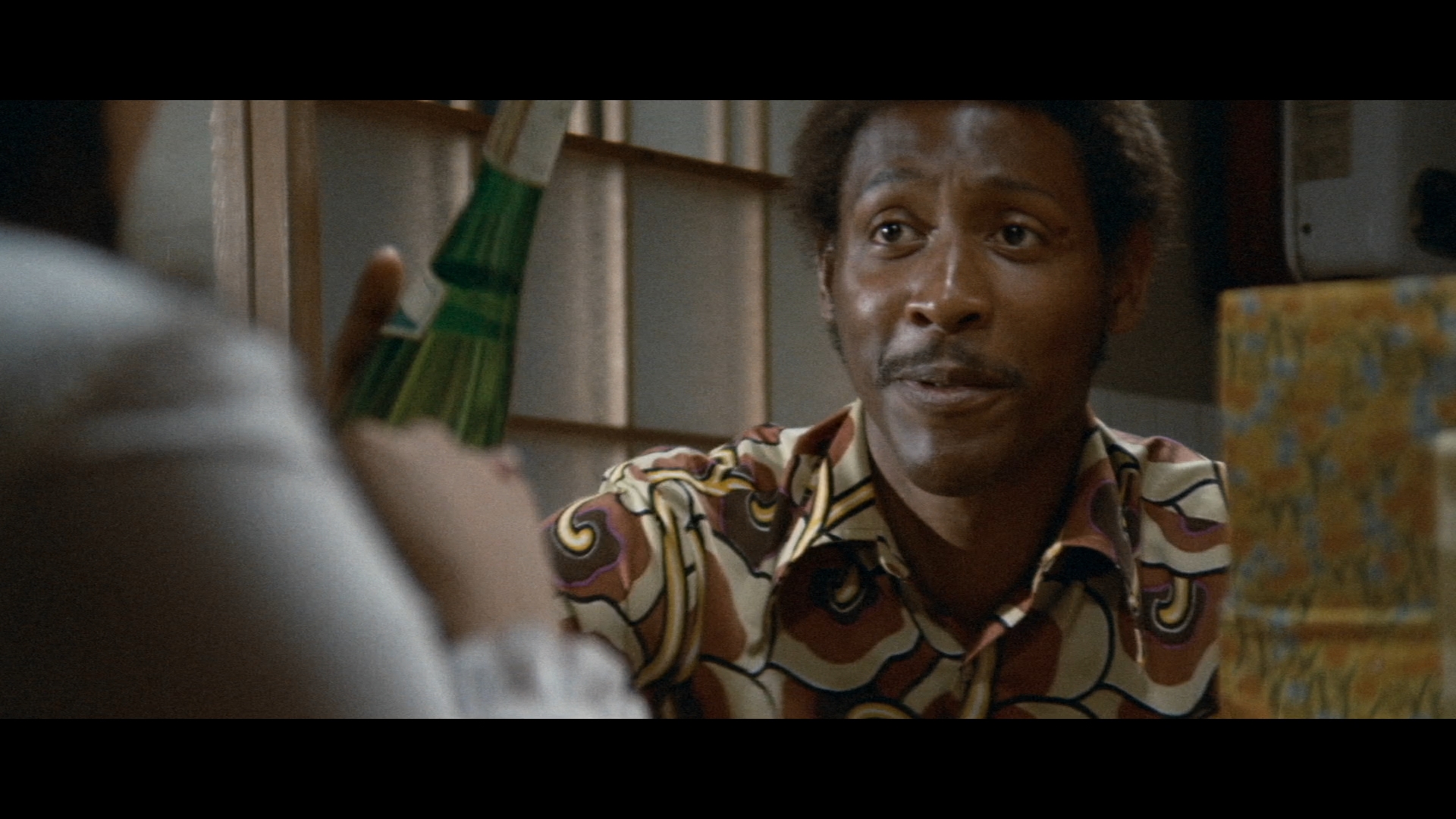 production bosses. Strangely, the action scenes are the least interesting aspect of this odd duck of a film; instead it's the film production sequences that really make it stand out, along with the commentary on racism with Wallace cast as a rare black main character in a '70s
production bosses. Strangely, the action scenes are the least interesting aspect of this odd duck of a film; instead it's the film production sequences that really make it stand out, along with the commentary on racism with Wallace cast as a rare black main character in a '70s 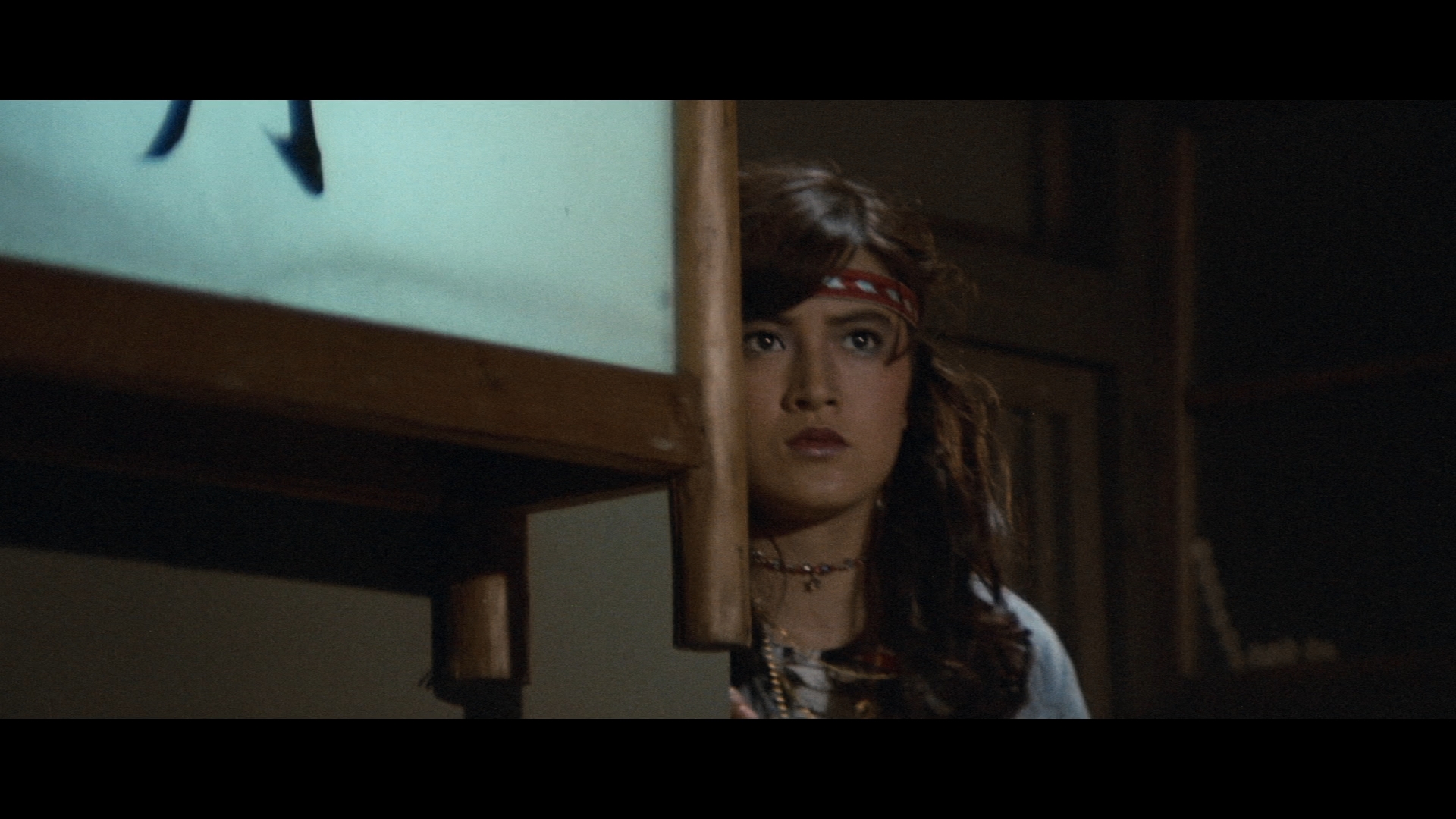 Japanese crime film.
Japanese crime film. 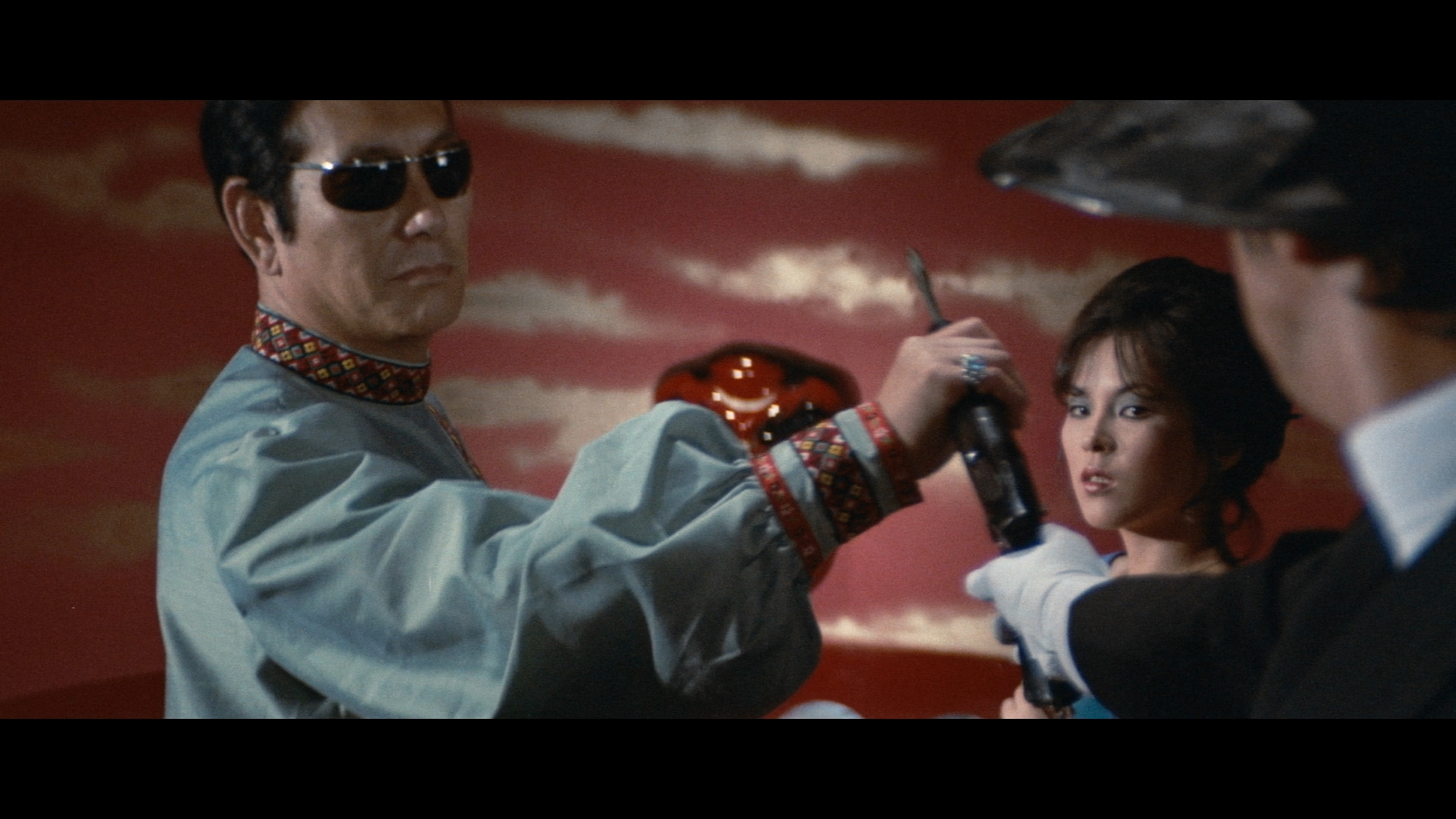 Japanese and English tracks with English subtitles, either translated or SDH for the dub, in LPCM mono; both sound very good. "Sonny Chiba: A Life in Action, Vol. 3" (10m10s) is another installment in Arrow's multi-part Chiba interview, this time focusing on his memories of Shihomi, who was initially passed over by the powers that be as an actress because of her unorthodox physique (for a movie star, that is). However, her remarkable prowess immediately caught Chiba's attention, and she was a valuable member of his Japan Action Club. Then the director gets his say in "Kazuhiko Yamaguchi:
Japanese and English tracks with English subtitles, either translated or SDH for the dub, in LPCM mono; both sound very good. "Sonny Chiba: A Life in Action, Vol. 3" (10m10s) is another installment in Arrow's multi-part Chiba interview, this time focusing on his memories of Shihomi, who was initially passed over by the powers that be as an actress because of her unorthodox physique (for a movie star, that is). However, her remarkable prowess immediately caught Chiba's attention, and she was a valuable member of his Japan Action Club. Then the director gets his say in "Kazuhiko Yamaguchi: 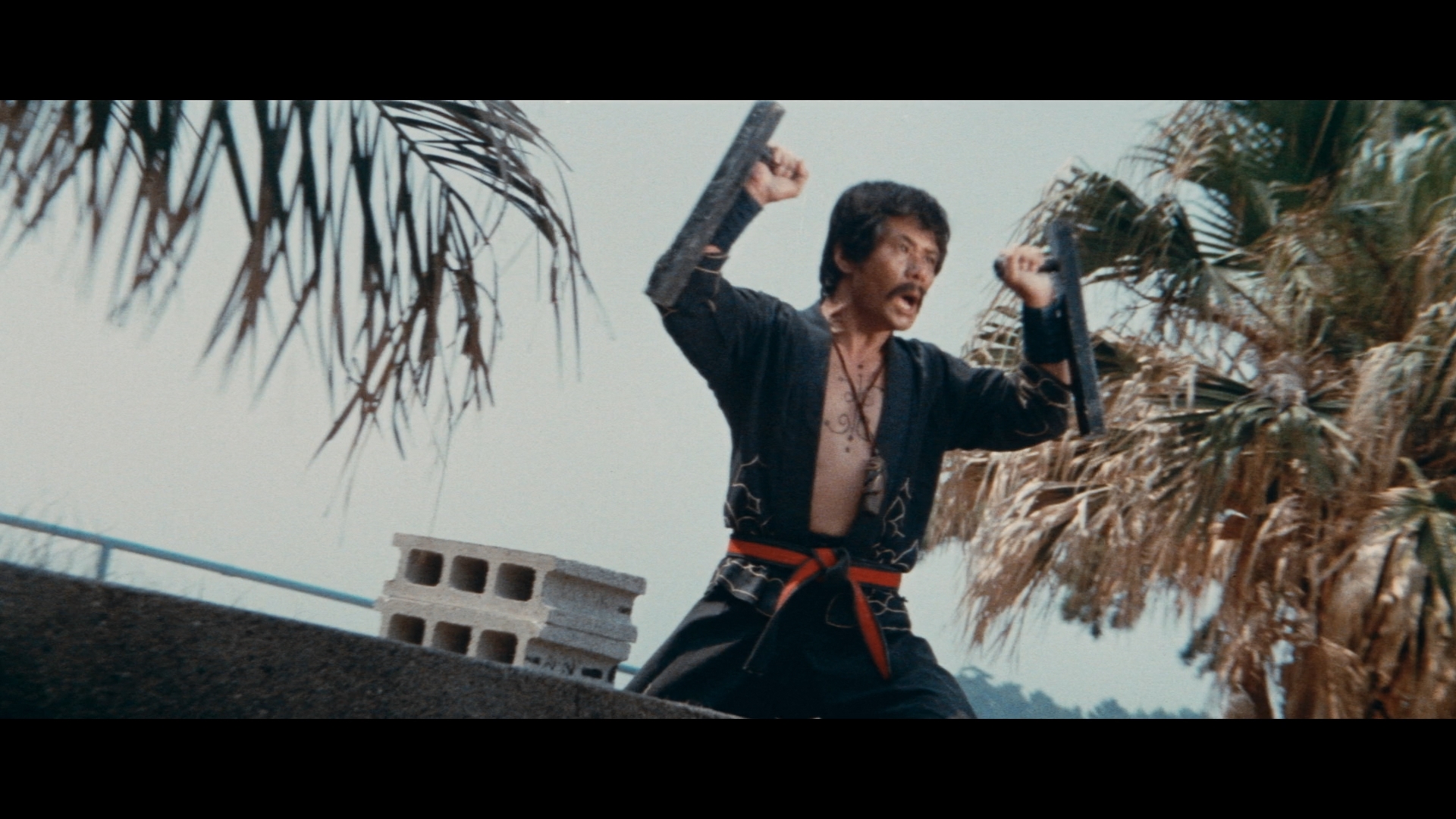 Kick Ass Sisters" (10m6s) about his own collaborations with his star, who was brought to him by Chiba, and the varying levels of action expertise among his cast as well as the need to create increasingly outlandish weapons and other films like Karate Bear Fighter. Finally, "Masahiro Kaketuda: Subversive Action" (10m51s) features the film's screenwriter chatting about his work on the first three films with his director, collaborator Norifumi Suzuki, and his penchant for writing erotic films versus action ones. He also explains his process of coming up with villains, with the second installment being his favorite. Between the three featurettes you get a solid, entertaining view of how the series came about, and you can easily watch any of them before heading on to the other films. A section for "International Releases" features a reconstruction of the film's U.S. R-rated version with a few SD inserts for footage with English text (81m13s), the U.S. trailer, and German opening titles and trailer (Die Karate Tiger). Also included is a reel of isolated score highlights (11m43s), the Japanese trailer (which is fantastic and must have packed 'em in), and a poster and stills gallery. The second disc features the remaining three films, all in Japanese LPCM mono with English subtitles; quality is consistent and generally quite good all across the board for each of them with most of the age-related damage minimized or removed entirely. Isolated score reels are included here for the second (19m26s) and third (10m15s) films, plus Japanese theatrical trailers for all three titles. The reversible sleeve features a new design by the appropriately named Kungfubob O’Brien, and the first pressing also comes with an insert booklet featuring liner notes by Patrick Macias and a Chris Poggiali overview of Toei's martial arts output.
Kick Ass Sisters" (10m6s) about his own collaborations with his star, who was brought to him by Chiba, and the varying levels of action expertise among his cast as well as the need to create increasingly outlandish weapons and other films like Karate Bear Fighter. Finally, "Masahiro Kaketuda: Subversive Action" (10m51s) features the film's screenwriter chatting about his work on the first three films with his director, collaborator Norifumi Suzuki, and his penchant for writing erotic films versus action ones. He also explains his process of coming up with villains, with the second installment being his favorite. Between the three featurettes you get a solid, entertaining view of how the series came about, and you can easily watch any of them before heading on to the other films. A section for "International Releases" features a reconstruction of the film's U.S. R-rated version with a few SD inserts for footage with English text (81m13s), the U.S. trailer, and German opening titles and trailer (Die Karate Tiger). Also included is a reel of isolated score highlights (11m43s), the Japanese trailer (which is fantastic and must have packed 'em in), and a poster and stills gallery. The second disc features the remaining three films, all in Japanese LPCM mono with English subtitles; quality is consistent and generally quite good all across the board for each of them with most of the age-related damage minimized or removed entirely. Isolated score reels are included here for the second (19m26s) and third (10m15s) films, plus Japanese theatrical trailers for all three titles. The reversible sleeve features a new design by the appropriately named Kungfubob O’Brien, and the first pressing also comes with an insert booklet featuring liner notes by Patrick Macias and a Chris Poggiali overview of Toei's martial arts output.![]()